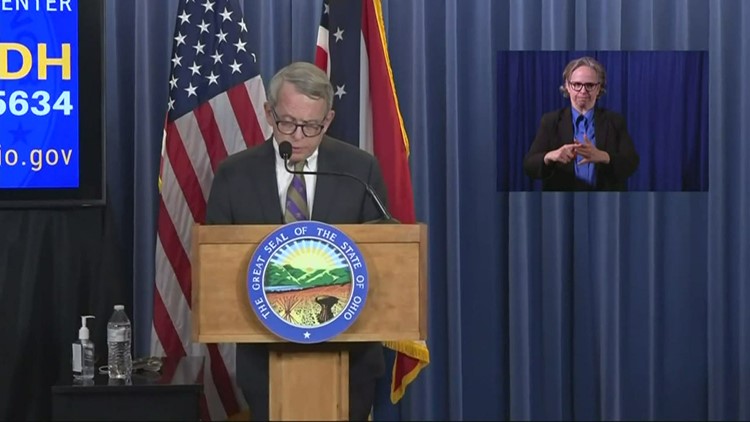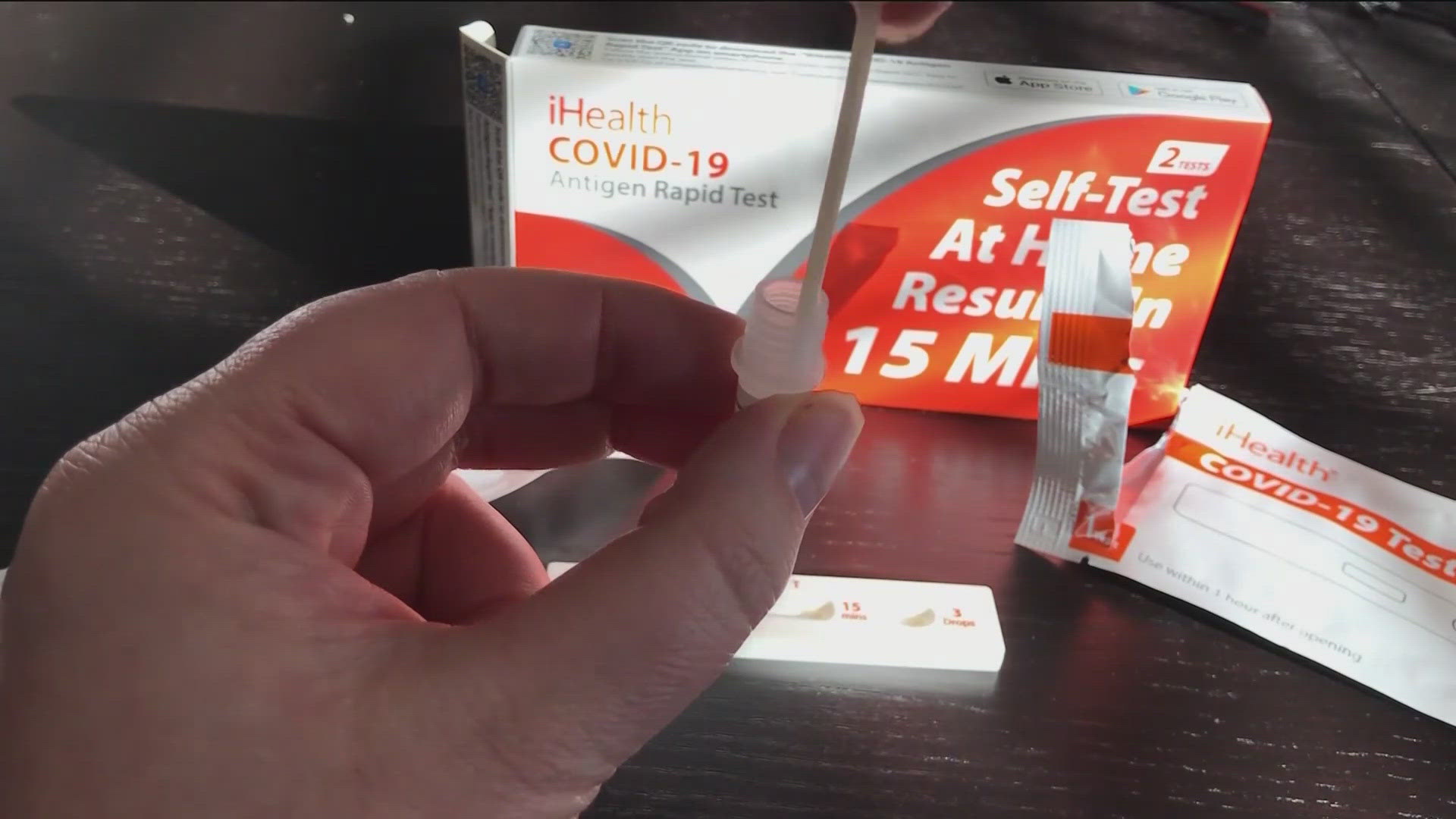COLUMBUS, Ohio — Ohio Gov. Mike DeWine held addressed the state on Thursday, updating Ohioans on his administration's response to COVID-19.
Here is a breakdown on Thursday's presser:
Dr. Amy Acton Steps Down
On Thursday, DeWine said that Ohio Department of Health Director Dr. Amy Acton had approached him and said she believed it was time for her to step down as the ODH Health Director.
However, DeWine said that he did convince her to stay on board as his Chief Health Advisor, where she will continue to serve Ohioans.
In the meantime, Lance Himes, who served as a past ODH Interim Director, will again assume the duties of Interim Director.
DeWine said that when he was elected governor, he knew he wanted a Director of Health with a strong public health background, someone who had a passion for public health and someone who could talk to Ohio citizens in a candid way about health issues.
With her leadership and help, in the first year, they focused on infant mortality, home visiting for at-risk, first-time moms, lead paint, youth homelessness, suicide prevention, and the modernization of our public health system.
"Her wise advice and counsel and connections with other doctors and health experts led us safely through those first few weeks," DeWine said.
DeWine said he was grateful for Acton's service to the people of Ohio as the Ohio Department of Health Director and that she always puts the health and safety of Ohioans first and foremost.
"Her knowledge, compassion and determination have set an example for all of us and Dr Acton's extraordinary bedside manner and wise counsel have helped us all get through this pandemic," he said.
In her new role, DeWine said that Acton will take a comprehensive and holistic approach to address health and well-being for Ohioans. In addition to advising on health issues, she will continue to work on the coronavirus crisis.
Acton said that she had been reflecting on the scope of work the position has entailed, including the usual work and the task of confronting the coronavirus pandemic, and she didn't want any aspect of the job to be short-changed. Her new role will allow her to completely focus on the task at hand.
Testing
In the beginning of the pandemic, DeWine said healthcare providers were asked to be selective about who was able to receive a coronavirus test due to a nationwide shortage.
However, on Thursday, DeWine said testing capabilities is no longer restricted, and any Ohioan who wants a test is now able to receive one.
An interactive map was added to the coronavirus.ohio.gov website that guides Ohioans toward testing sites in their area. The resource is continuously updated as more testing locations pop up. You can find that map by clicking here.
Healthcare providers can also add themselves to the list by filling out a form on that same page. Pop-up testing sites will also be available throughout the state in the coming weeks.
Churches
DeWine reminded Ohioans that churches have always been exempt by nationwide closures, but acknowledged that many closed their facilities anyway, providing services virtually to keep people safe.
Many are beginning to return to in-person service and in an effort to help keep church-goers safe, the Ohio Department of Health released a list of best practices. None of these guidances are mandated or required and are only meant to serve as a resource for church leaders should they wish to use it.
Those best practices can be found by clicking here once they are made available.
Business
For the sixth straight week in Ohio, renewals for unemployment claims have declined.
With many sectors reopening, a large number of Ohioans are returning to work and the economy is beginning to recover.
Dislocated Worker Grant
Lt. Gov. Jon Husted announced Thursday that Ohio Job and Family Services will receive an $8.5 million federal Employment Recovery National Dislocated Worker grant to help re-employ individuals who lost their jobs as a result of the COVID-19 pandemic and help employers rebuild their workforces.
Minority Business
Husted also announced that through Jobs Ohio, 13 minority-owned businesses in Stark County, Ohio will be participating in the London Stock Exchange's ELITE program, which has been a work in progress pre-COVID.
TUESDAY, JUNE 9
PPE
As of last week, the state has distributed over 30 million pieces of personal protective equipment (PPE). Of those pieces, 27.8 million have been shipped to county EMAs for distribution. DeWine said this is a "work in progress."
The Ohio Bureau of Workers' Compensation's "Protecting Ohio's Workforce- We've Got You Covered” program has also sent over 1.5 million face coverings to support and enhance any workforce safety and health efforts businesses already have in place.
DeWine said his team has provided PPE to state institutional agencies to ensure they have a 90-day supply. PPE has also been made available to Ohio Mental Health and Addiction Services through their Office of Pharmacy Services, to support requests for PPE from state agencies, boards, and commissions.
Additionally, state leaders are looking at longer-term contracts for ventilators and N-95 masks. They are currently evaluating the results of a recently issued invitation to bid for gloves, gowns and three-ply masks.
Dr. Susan Koletar - Infectious Disease Physician
The World Health Organization recently stated that it is "rare" for asymptomatic coronavirus patients to spread the virus to others.
Infectious disease physician with The Ohio State University Dr. Susan Koletar explained there is a difference between people who are truly asymptomatic and people who may be "pre-symptomatic."
Those who are asymptomatic show no symptoms of the virus and never go on to develop them. Pre-symptomatic people may have some symptoms that don't cause much of alarm or disruption, like fever or a bit of a sore throat. Those people generally go on to develop more classic coronavirus symptoms.
Koletar said she isn't sure we actually know how many asymptomatic people go on to transmit infections because we haven't done that type of contact tracing. However, we do know people who are pre-symptomatic are likely infectious.
Koletar said she thinks the best way to move forward is to just keep doing what we have been doing: assess people with symptoms, increase the public's awareness of what the symptoms might be and continue health practices like social distancing and frequent hand washing.
In terms of masks, she said this stems from that pre-symptomatic source of spread. When everyone wears a mask, that greatly lessens the chance of spread from person to person.
Infectivity, she said, is related to time and distance. The longer you are in close proximity, the greater chance for infection.
BMV
Prior to Tuesday's conference, leaders with the Ohio Bureau of Motor Vehicles announced a bit of good news, with a date for driver's license testing set to begin again.
Driver examination station skills testing will resume on Friday, June 12 at select locations by appointment only, which can be made online here. The locations set to pickup exams on Friday include:
• 8210 County Rd. 140, Suite C, Findlay, Ohio 45840 (Hancock County)
• 22133 Rockside Road, Bedford, Ohio 44146 (Cuyahoga County)
• 990 Morse Road, Suite B, Columbus, Ohio 43229 (Franklin County)
• 873 East Main Street, Newark, Ohio 43055 (Licking County)
• 502 McCarty Lane, Suite 3, Jackson, Ohio 45640 (Jackson County)
• 10940 Hamilton Ave, Cincinnati, OH 45231 (Hamilton County)
All other driver examination station skills testing will resume on Tuesday, June 16 by appointment.
Important to note: the driver's license test will be adjusted to adhere to Ohio Department of Health guidelines. Individuals who are tested will be scored by the examiner from outside the car in an effort to maintain six feet of distance.
If you had a tests canceled due to COVID-19, a BMV representative should be reaching out to you for priority-based scheduling.
What else is reopening?
Ohio's economy is almost completely reopen, as many sectors have picked up business with health and safety guidelines in place.
Last week, DeWine announced another round of reopening dates.
On Wednesday, June 10, the following entertainment venues were able to reopen:
- Aquariums
- Art galleries
- Country clubs
- Ice skating rinks
- Indoor family entertainment centers
- Indoor sports facilities
- Laser tag facilities
- Movie theaters (indoor)
- Museums
- Playgrounds (outdoor)
- Public recreation centers
- Roller skating rinks
- Social clubs
- Trampoline parks
- Zoos
After that, on June 19, casinos, racinos, amusement parks and water parks will be able to open under certain ODH restrictions.
Health orders will be posted on coronavirus.ohio.gov when available, the governor's news release said.
Police reform
DeWine said that as of today, 79% of Ohio’s law enforcement officers work for an agency that is certified - or is in the process of becoming certified - in Ohio’s use-of-force and hiring/recruitment standards, created by Former. However, the total number of certified agencies is only around half of all of Ohio’s departments.
Regardless of why some agencies have not become certified, DeWine said, he is encouraging the more than 400 agencies that are not certified to begin working on this process immediately. He has directed the Ohio Office of Criminal Justice Services to reach out to these agencies to assist them in any way they can.
A report listing Ohio’s law enforcement agencies that have (and haven’t) chosen to pursue certification on these minimum standards is available here.
DeWine also instructed the Ohio Collaborative Community Police Advisory Board to create yet another standard; this time, on law enforcement's response to mass protest. They are asked to examine the following:
- At what point in a protest do measures like tear gas, pepper spray, non-lethal projectiles become necessary?
- What tactics and techniques are, in fact, best practices when dealing with a crowd that is failing to disperse?
- How can law enforcement prevent members of the media from being injured?
- When do tactics become excessive for the given situation?
DeWine said that when protests move from peaceful to violent, law enforcement must act. He clarified that his team is not looking to give the small number of violent protesters to get a free pass. However, he said that he wants peaceful protesters to feel safe when asserting their first amendment rights, and for the public to be protected from violence and destruction of their property.
DeWine said he would welcome anyone's input on additional, uniform standards throughout the state of Ohio.
Minorities and Women in the Police Force
DeWine said that through the use of existing resources, a new Ohio Office of Law Enforcement Recruitment Department will be created within OCJS to help local agencies with the recruitment and retention of minorities and women in law enforcement.
He said this is just the first round of announcements related to meaningful law enforcement reform. According to DeWine, many necessary changes will require legislative action, and his team is working on other ideas alongside the law enforcement community, elected officials and community organizations.
Funding
Protesters across the country have called for municipalities to defund police departments. However, DeWine said he is not interested in defunding Ohio law enforcement agencies, calling the idea "absurd."
However, he made clear that he is in favor of major reform.
We will continue to keep you updated.



